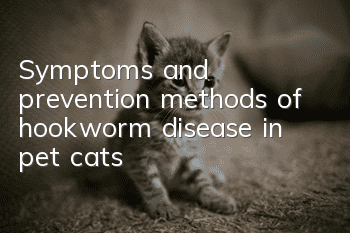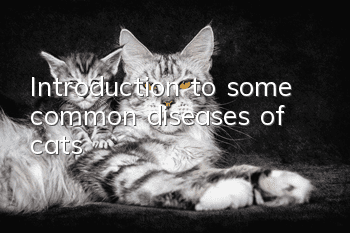Symptoms and prevention methods of hookworm disease in pet cats

Cat hookworm disease is more harmful and is more common in tropical areas. The disease can cause many adverse reactions in cats, such as weight loss, smelly feces, itching, vomiting, skin bleeding, etc. It is a highly harmful parasitic disease that cannot be ignored.
Symptoms:
1. When infected through the skin, it sometimes causes localized dermatitis of the skin.
2. The main clinical symptom is anemia caused by bleeding from the blood-sucking site of the adult worm.
3. Acute hookworm disease often occurs in young cats. They assume a hunched-back posture and excrete tar-like feces and sticky bloody feces with a putrid odor. The mucous membranes may be pale, the appetite is lost, and they lose weight rapidly due to dehydration.
4. Chronic cases show persistent weight loss, laziness, dull coat, and no special abnormalities in appetite and feces. As the disease progresses, weakness and cachexia occur, and sometimes death occurs.
Treatment:
You can refer to the treatment methods for ascariasis, oral ivermectin is effective. For cats, toluene can be used at a dose of 0.1 to 0.2ral/kg body weight, orally or mixedly fed; diphenol can also be used for subcutaneous injection at 9.9 mg/kg body weight.
Prevention:
1. Keep the cattery clean and hygienic, clean up feces in time, frequently spray the areas where cats move with disinfectant to kill larvae, and deworm cats regularly.
2. For milder cases, they can be cured by deworming; for severe cases, symptomatic treatment is required, such as blood transfusion, insulation, fluid rehydration, etc.; for cases of enteritis and intestinal bleeding, hemostasis and intestinal mucosal protective agents should be used.
3. For deworming, 7.5 to 10 mg of carbolic acid per kilogram of body weight can be injected subcutaneously, but the dose should be controlled. For young cats, it should be diluted before injection; 10 mg of thienopyridine preparation per kilogram of body weight can also be taken orally on an empty stomach; Or use ivermectin 0.3 mg per kilogram of body weight, subcutaneous injection.
- How to train a cat to understand the "come here" command? Cat training!
- First aid method for cat shock, a must-have for families!
- What do I need to transport a cat on a plane?
- Male cats sometimes meow at night
- Why does a Siamese cat’s coat color change?
- How to train a cat to be obedient and well-behaved, the secret to making a cat obedient!
- What is the personality of the Russian Blue cat?
- What foods do cats like to eat?
- Is it necessary for cats to eat hair removal cream? These natural hair removal methods are healthy and effective!
- What causes cats to be picky and anorexic?



